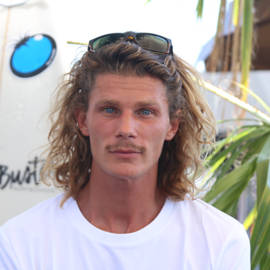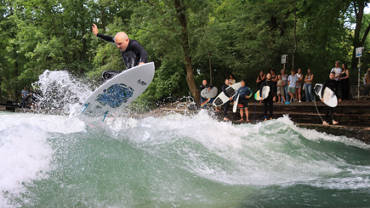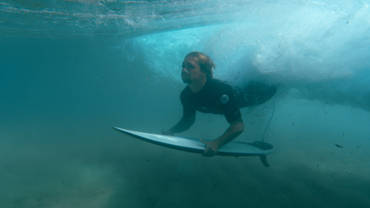How to start surfing
Goofy or Regular
As with any other board sport, the first question that arises is whether you stand on your board goofy or regular, i.e. with your left foot in front (regular) or your right foot in front (goofy). Most board sport enthusiasts will have the same foot in front as they do when snowboarding or skateboarding. If you don’t have any experience in board sports yet, you can use this easy and simple technique: let a friend push you from behind. The foot that you use first to catch yourself is usually your front foot and hence can be placed in the front of your board.
Foot positioning
It is important not only to know which foot is in the front and which in the back, but also how exactly these are positioned on the board. The rear foot ideally should be positioned at a 90-degree angle to the board and placed at the rear end of the surfboard, roughly on one level with the rear fin. The front foot is positioned roughly in the centre of the board and turned slightly towards the front. This makes it easier to turn the hip when surfing, which is especially critical for initiating turns and other manoeuvres. It is also important that you hold a good balance between your feet and that you do not shift your weight too far back or too much forward. The weight distribution also defines at what height level on the wave you are surfing. As soon as you put more weight on your back foot, you fall back a little and automatically surf further up on the wave. On the other side, when putting more weight on your front foot means sliding deeper down into the wave.
Entering into the wave
Whether you are Goofy or Regular also defines on which side it is easier for you to get into the wave. In the beginning, it makes sense to have the wave in front of you. With Regular this means entering on the left and with Goofy on the right side of the wave. First of all, make sure that you attach your Surfboard leash to the back foot just above the ankle. For regular surfers, that means on the right foot, for goofy on the left. When entering into the wave, you sit on the edge of the wave and put your board gently in the water in front of you with your nose showing upstream. Hold on tight so that the board doesn't get washed straight away. Place your feet on your surfboard as described above and slowly shift more and more weight onto the board until you are standing upright. You can hold on to the sidewall of the wave to get a better feel for the water and the board. When you have balanced yourself out, gently push yourself off the sidewall and surf the wave.
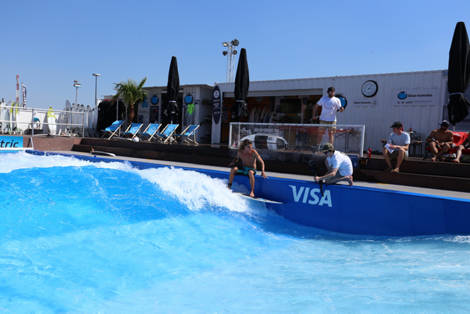
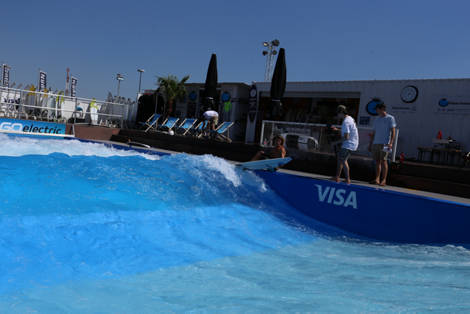
Falling
When you fall, make sure to protect your head by raising both arms in front of your face over your head and grab the back of your head. Try to fall as flat as possible into the water, especially at river waves, there are often stones at the bottom. Behind the wave, pick up the board as quickly as possible and leave the danger zone. On artificial waves, you can usually walk out to the back, on river waves you have to paddle to the sides and climb out. Even if rivers don't seem quite as dangerous as the sea, don't underestimate the currents. It also happens from time to time that the board shoots out of the water and thus becomes a source of danger, especially pay attention to the fins. At river waves, the walls are often made out of stone or concrete - you should also stay away from these. Therefore it is important to always fall correctly and consciously.
The first turn
Unlike with snowboarding or skateboarding, turns in surfboarding are not initiated with the feet, but rather in the upper part of the body. This means, that as soon as you turn with your upper body in one direction, your legs will follow as well as your surfboard. In the beginning, this is a static process but after a while it will loosen up when you feel more comfortable on the wave. It also helps a lot to look into the direction where you want to surf. Reason for this is that you automatically turn your upper body also in the direction your head is pointing.
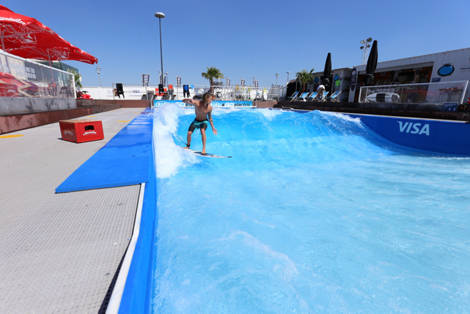
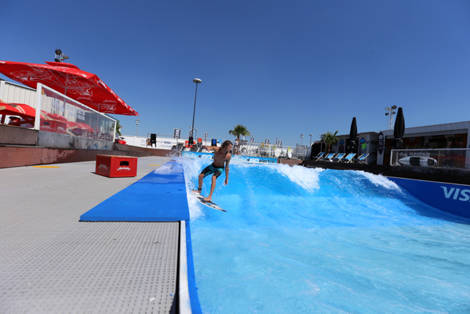
Perfecting turns
The faster you surf, the more aggressive your turns will become. You automatically will surf more on your rails, i.e. the edges of the surfboard and can therefore build up more pressure in your turns. The goal is to surf a so called "lying eight" by positioning yourself on the wave. Here you take the speed from the upper part of the wave to the other side and can even try your first sprays.
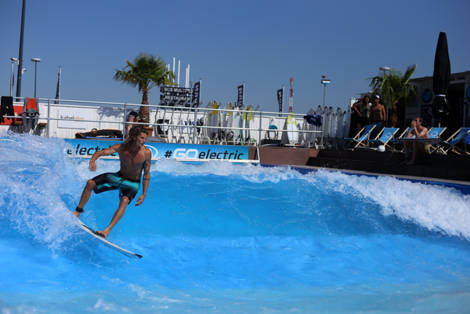
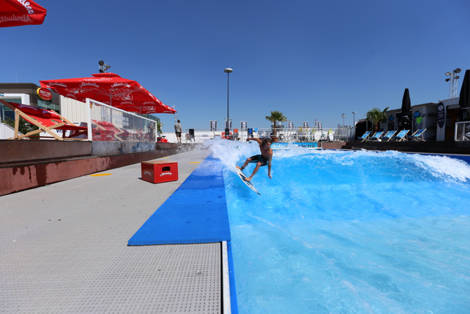
Surf etiquette – Keep your distance & watch out for other surfers
As in other sports, surfing stationary and river waves also come with general rules that should be followed.First and foremost you should always watch out for yourself and the people around you. That means you should carry your board close to you and also keep the leash close to your body so that nobody walks on it and gets entangled. You should also always keep a distance of about one meter to the other surfers. This prevents you from bumping into each other with the surfboards.
Surf etiquette - Knocking on the board
Knocking on the board can mean two things: On the one hand, recognition or "props" when a surfer lands a difficult or new trick. On the other hand, knocking on the board can also indicate that the current surfer has been on the wave for too long and should make room for the next one. It has become an unwritten “rule” that every surfer should do about four to five turns and then try something new or a trick. This way, everyone gets to surf more often and can try out new tricks themselves.
Surf etiquette - Party Wave
Surfing a Party Wave means surfing the wave with one or more surfers at the same time. You have to make sure that you share a wave with people who have a similar surfing level as you do. In this case you can surf different maneuvers like crossing each other. Especially with Party Waves you have to make sure that you fall correctly, always protect your head and don't put the other surfer in danger.
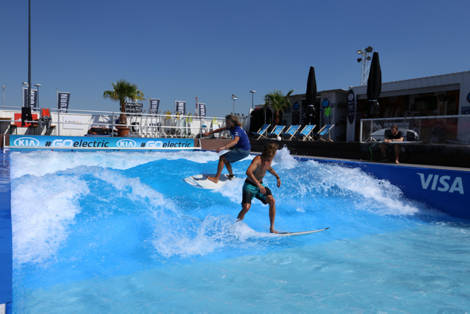
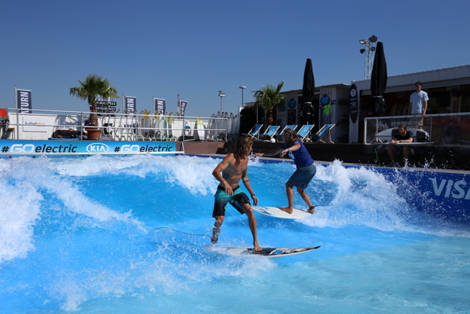
Surf Gear
In addition to the necessary knowledge, surfing also requires the right surf equipment. First of all, you have to decide which surfboard to buy. The most important choice to make is between soft- and hardboards. Softboards are good for beginners because these boards are robust and you minimize the risk of an injury. These boards are in general also more difficult to damage, for example, if they touch the side walls. Hardboards become interesting if you want to do faster turns and proper manoeuvres. Hardboards are divided into polyester and epoxy surfboards, depending on the material used in the surfboard. Epoxy surfboards are a little bit more robust than polyester surfboards and have more buoyancy, but are also heavier. The choice of the right surfboard is, as always, a matter of taste and depends on many other factors like weight and height of the surfer, surfboard brand, purpose of the surfboard, etc.
Fins
In addition to the surfboard, you also need fins, which prevent you from sliding away on the wave. Especially for river surfing, a thruster set-up is recommended, i.e. a small centre fin and two side fins. The small centre fin gives the surfer enough traction to make nice turns and is small enough to turn a 360.
Traction Pads
For the necessary traction on the board, the right pad or wax is used. Classically, a tail pad is glued to the back end of the board and the wax is applied in the centre of the board to provide support for the front foot. However, with river surfers, you often see front pads as well, because the paddling aspect is omitted and you are not lying on the board. Rarely there is no pad at all, and only wax in the front and back. This decision is up to each surfer and often depends on the style of the respective surfer and the area of use of the surfboard. When choosing the right wax, you should also pay attention to the manufacturer's recommended water temperature. The wax only offers optimal grip in the water temperature for which it was made.
Leashes
In order to keep the board with the surfer at all times and to prevent waiting surfers from being injured at the edge or the board being dragged away by the current, a leash is attached to the surfboard. The length of the leash again depends on the length of the surfboard and should be about the same length as the board.
Surfwear
Depending on the outside or water temperature, wetsuits are recommended. They protect you from the cold and from skin scrapes. There are shorty and full suits as well as frontzip, backzip and zip-free versions. To find out which one is the right one for you, check our Wetsuit Buyer's Guide. A poncho protects you from glances while changing and keeps you warm after your session. To repair smaller dings quickly, it is worthwhile to have a repair kit with you. All these and many more products you need for surfing can be found in our stationary stores and of course in our webshop.
Advanced Surf Techniques
Drop-In
The Drop-In is the advanced way to get into a standing wave. No more sitting down and awkward feet placing, but jumping directly onto the wave with the board. You can hold the board with one or two hands. Two hands offer more stability than one hand. It is also important to land on the board with both feet at the same time, ideally in the correct foot position, and go directly to your knees to absorb the impact. Furthermore, you should not land too far up on the wave, but also not too far down. If you are positioned correctly, you can take the momentum of the drop-in with you and thus initiate a powerful turn. When starting the Drop-In, make sure that the leash is not stuck anywhere or wrapped around your own feet. The frontside Drop-In is easier than the backside Drop-In, because you can see the wave in front of you and you can jump in straight forward. With the backside Drop-In you hold the board in your hand that is closer to the water. With the other hand you can hold the leash so that you don't stumble over it. The jump is so to speak backwards and therefore a bit more difficult, but with a little practice it works just as well as frontside.
Spray
A spray is created when you have enough speed in a classic turn and powerfully push the tail into the wave with your back leg. This pushes a lot of water away and you can allow the waiting surfers to cool down. For the frontside spray, the surfer rides up the wave, leaving the front foot stretched out, while the rear foot remains bent. Once you reach the highest point of the wave, the spray is initiated by the rotation in the upper body and the feet follow. When you have enough speed, timing and pressure over the back foot, you execute a proper spray. When initiating the backside spray, you look behind the wave and make a similar rotation as with the frontside spray. If you kick on the tail at the highest point of the wave, you should have enough power to make the water splash.
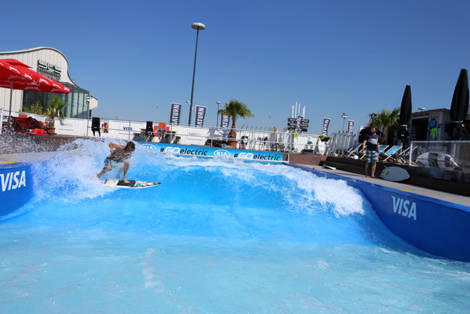
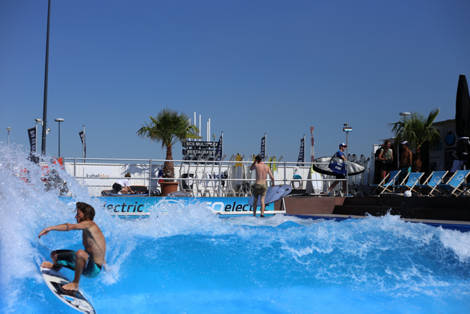
How to Frontside (FS) 360
The Frontside (FS) 360 is a classic among the advanced river surf tricks. The FS 360 is directly initiated with the frontside turn. You rotate the turn almost to the end and instead of continuing to surf on you rotate your upper body even further than before. With the front hand you can reach into the water, while the back hand initiates the rotation. As soon as your head and upper body rotate, your feet and the board will follow. It is important to keep your balance as soon as the fins break out, aka when you rotated 180 degrees and the fins have no more traction. Complete the rotation with the head and upper body and the feet will follow. With fewer (for example two instead of three) or smaller fins, the rotation will be easier, because there is less resistance to overcome.
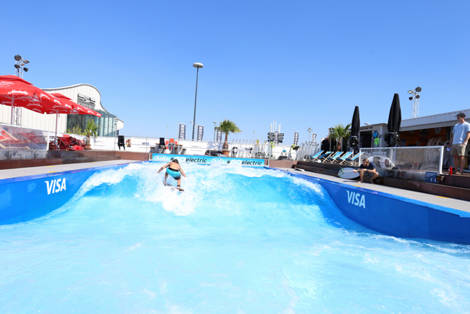
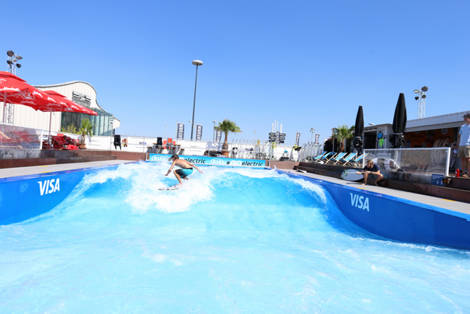
How to Backside (BS) 360
Similar to the Frontside 360, the Backside 360 is initiated directly during the turn. You either hold both or only one hand into the water behind you. This will cause the head and upper body to rotate backwards. The fins should break out by putting enough weight on the front foot. You can do this by turning your back knee towards the board and leaning slightly towards the tail. You should also stay small in order to keep enough stability on the board. As soon as the first half of the turn is done, rotate your head and upper body further so that the remaining 180 degrees can still be executed. Many surfers find the Backside 360 easier than the Frontside 360, which is of course a matter of taste and has to be tried out by every surfer themselves. As always: Practice makes perfect.

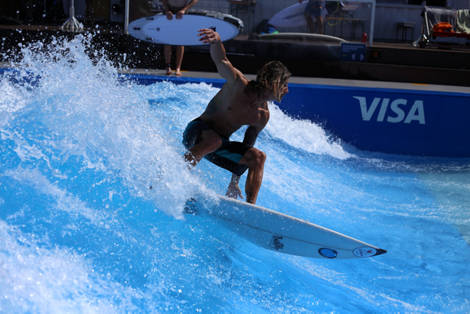
Surfparks
When the ocean is too far away, there are plenty of surf spots where you can experience surfing without having to fly miles. Surf parks have emerged in the middle of Europe and around the world in recent years, offering everything from gentle waves for your first steps to really huge waves. Here you are right in the middle of the surf scene and can learn the right skills step by step with professionals. Be it at The Wave in Bristol (England), Alaïa Bay in Valais (Switzerland) or Wellenwerk in Berlin (Germany), to name just a few of the well-known surf parks. Others are also currently under construction, such as in Augsburg (Germany), where the Augsburger Welle is being built, or in Munich, where the O2 Surftown MUC, a wave pool for surfers of all levels including a leisure park, is about to open. In addition to surf parks like these, there are also river surf parks in rivers, but that's another story in the infinite world of surfing.



